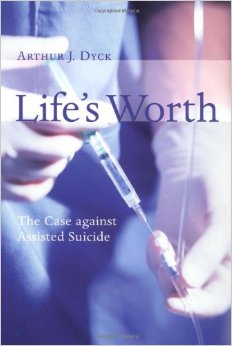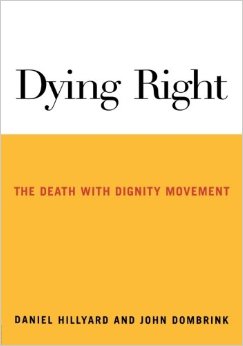The next few chapters consider the legal, moral, and spiritual aspects of this discussion.
The legal aspects are difficult. Protecting life is a major function of law, but protecting freedom is also an important goal of American jurisprudence. Generally the legal debate centers on these two protections. The first of the following pieces argues that laws preventing physician-assisted suicide are inhumane.
The Inhumanity of Laws against Doctor-Assisted Suicide
By Michael A. LaFerrara (Source)
On November 1, [2015], twenty-nine-year-old Brittany Maynard, suffering from terminal brain cancer, took her own life under Oregon’s assisted suicide law. California, Maynard’s home state, doesn’t allow doctor-assisted suicide. So she moved to Oregon, where she could legally die on her own terms.
Currently, assisted suicide is unequivocally legal in only three states—Oregon, Washington, and Vermont—where it is allowed in cases of terminal illness in which doctors estimate that the person in question will die of his illness within six months. In Montana and New Mexico, although courts have ruled in favor of physicians assisting in the suicide of terminally ill patients, the legal situation appears unsettled. But even in Oregon, Washington, and Vermont, the laws do not fully recognize and protect an individual’s right to take his own life or to contract with a medical professional for assistance in this regard.
Consider the plight of New Jersey resident Christina Symanski a few years ago. As Bob Braun of New Jersey’s Star-Ledger recounts, Symanski was paralyzed from the neck down in a diving accident in 2005. After years of agonizing physical and emotional struggle, and facing hopeless decades in a state she considered “intolerable,” Symanski chose to end her own life. As Braun notes, Symanski searched for but could not find a legal way to get assistance from a medical professional—not even in Oregon. So, in 2012, she literally starved herself to death through “a slow and torturous . . . agony that lasted two months.” In a widely viewed final statement on her blog—written before her death but published afterward—Symanski explained how and why she came to her decision. Her post, titled “Quality vs. Quantity,” closed as follows:
I feel justified in saying I’ve suffered enough. I feel it’s horribly unfair, that I’m forced to live, the way paralysis has forced on ME. I’m not talking about “quadriplegics,” I’m talking about Christina Symanski. . . . I can’t speak for anyone but myself, in terms of quality of life. . . . So then I’m left with the question, “is it really worth living?” Not for everyone else’s reasons, or for anyone else, but ME. . . . I don’t view THIS as a quality life.
Life for a human being is not merely about breathing or having a pulse. A human life is about pursuing the goals and values that, according to one’s own judgment, will make one’s life enjoyable and worth living. In dire circumstances in which a person is unable to live the kind of life that he or she regards as worth living—and only the individual can make such a determination—it may be the case that remaining alive is a fate worse than death. Life is not merely about quantity; it is also, and more importantly, about quality.
Both Brittany Maynard and Christina Symanski bravely chose to decide for themselves the terms on which they would live and die—and both women bravely chose to make their decisions and struggles public in order to highlight the inhumanity of laws forbidding assisted suicide.
In a country founded on the rights to life, liberty, and the pursuit of happiness, most states nevertheless forbid a person to exercise these rights when the pursuit of happiness becomes impossible. This means a person in personal agony with no hope for a future of happiness legally must remain alive and suffer. That is a moral disgrace. As Maynard wrote in a widely publicized CNN.com op-ed: “I would not tell anyone else that he or she should choose death with dignity. My question is: Who has the right to tell me that I don’t deserve this choice?”
—
Others maintain that it is important to protect life by not allowing physician-assisted suicide to become legal. The following interview is a clear presentation of that case.
A Progressive Argument Against the Legalization of Physician-Assisted Suicide
The Pew Research Center (Source)
The debate over physician-assisted suicide is often portrayed as a battle between social or religious conservatives who oppose the practice and liberals or progressives who support it. But not everyone fits neatly into this paradigm. For instance, Dr. Robert P. Jones, who calls himself a progressive, has just written a book urging liberal supporters of physician-assisted suicide (or physician aid in dying, as some supporters call it) to rethink their views, at least for now.
In Liberalism’s Troubled Search for Equality: Religion and Cultural Bias in the Oregon Physician-Assisted Suicide Debates, published earlier this year by the University of Notre Dame Press, Jones argues that the debate over whether to allow physician aid in dying should wait until the United States guarantees adequate access to health care to all of its citizens. Jones, who does not in theory oppose physician-assisted suicide, argues that without health insurance terminally ill patients could end up choosing or be pressured into choosing to prematurely end their lives for financial or similar reasons.
Jones, who holds a doctorate in religion from Emory University, is an independent consultant on religion and progressive politics and an affiliated scholar at the Center for American Progress. From 2005-2006, he served as the founding director and senior fellow of the Center for American Values in Public Life at People For the American Way Foundation. He currently serves on the national steering committee for the Religion, Politics and the State Group of the American Academy of Religion and on the national board of FaithfulDemocrats.com. He is completing a new book, to be published in July 2008, based on interviews with progressive religious leaders in Judaism, Christianity, Islam and Buddhism entitled Progressive and Religious: The New Face of Religion in American Public Life.
Interviewer:
David Masci, Senior Research Fellow, Pew Forum on Religion & Public Life
You say in your book that both liberals and progressives incorrectly view physician-assisted suicide as another “choice” issue, like abortion. Why isn’t this issue about someone’s right to decide his or her fate at the end of life?
My argument is really a social-justice-oriented argument against the legalization of assisted suicide in our current health care context. And those last words are really important: in our current health care context. I think one important piece may be the number of uninsured Americans that we have in the country. The recent numbers that came out from the U.S. Census Bureau saw the number of Americans without health insurance rise to 15.8 percent – or 47 million people in our country. What that means – and what I argue – is that legalizing assisted suicide in the context where we have this kind of inequity in our health care system actually puts those who are uninsured at risk for reaching for assisted suicide for a financial necessity or out of some duress.
So to put it starkly, if you’re faced with the choice at the end of life where one option is between $50 and $150 for a lethal prescription of medication to end your life versus tens of thousands or even hundreds of thousands of dollars for long-term care, that’s a pretty draconian choice to put in front of people.
You can see this situation coming out if you look at the demographics of people who are for and against assisted suicide. The country is fairly evenly divided if you look at Pew polling on this issue. But I argue that if you start looking underneath the numbers and you look at the poor or at minorities, a different picture emerges. According to my own analysis of the Pew data, you have 61 percent of whites with incomes over $100,000 supporting physician-assisted suicide, but you have 78 percent of minorities with incomes under $50,000 opposing assisted suicide. That picture, I think, ought to tell us something – specifically, that those more vulnerable populations who are less likely to have health insurance and large financial resources are also less likely to support physician-assisted suicide. We shouldn’t move too quickly past those numbers.
A group that has been very prominent in these debates is the disability-rights movement. In August 2007 there was an article in the Los Angeles Times that cited opposition to assisted suicide coming from an unusual place – the disability-rights movement, which is concerned about people with disabilities being very vulnerable in our current health care context. That movement is really worried that financial incentives may push doctors to make certain decisions or push patients to make certain decisions that I think we couldn’t call a free and non-coerced choice.
So what you are saying, in essence, is that lack of universal health care increases the risk that legalizing physician-assisted suicide will ultimately lead to abuses?
I think that’s right. You mentioned earlier this analogy with abortion, that there’s a kind of pro-life/pro-choice thing. I think one of the mistakes that has been made around the assisted suicide debate is to too easily try to fit that framework over this issue and say that if you’re pro-life, you should be against physician-assisted suicide, and if you’re pro-choice, you should be for it.
But I think that obscures the real financial issues here, and what I’ve been arguing is that a more appropriate analogy might be the capital punishment debate. That argument goes like this: Regardless of whether or not – in the abstract – we could justify capital punishment for certain heinous crimes, in the current context of our society, which is shot through with racism and shot through with financial problems of representation in the courts, we can’t justly implement it.
And what I’m arguing is that a very similar kind of argument ought to be made by progressives on the issue of assisted suicide – that regardless of whether we can make an argument that physician-assisted suicide in certain cases is a social good or is morally justifiable, in our current health care context we can’t justly implement it in a way that doesn’t lead to increased risk to the disadvantaged and the vulnerable in society.
Let’s assume that in the next few years the United States moves from its current health care system to a European-style universal care model and everyone has access to health care. That takes out of play your big concern. At that point, should people still have qualms about physician-assisted suicide? Are there still issues that need to be explored, or are we now ready to move on to that?
My argument is that [universal health care] ought to be the floor that is in place before we really have this debate. And at that point I think the argument is moving to a different space. I’m arguing that at least the justice claims of the poor, vulnerable and disabled ought to be met before we open up this debate, and I think it’s a debate we ought to have. We ought to have it in the legislatures and in public, and it’s one that I think is a healthy debate for the country.
One of the most interesting comments I found was by Dr. Rob Jonquiere, head of the Dutch Voluntary Euthanasia Society. He is a very strong advocate for these rights at the end of life in the context of the Netherlands, but when asked about what the U.S. ought to do, he basically said no. He said that in the U.S., where so many people are uninsured, you could not defend such a law. And this is from someone who is a staunch advocate for the right to assisted suicide and euthanasia at the end of life. And I think that really does set the floor below which we shouldn’t go in the U.S.
In your book you take liberals and progressives to task for ignoring the role that religion can play in this discussion. Why do you think the left has excluded religious considerations on an issue like doctor-assisted suicide?
Religious views got dismissed in the debate in a couple of ways that I find really unfortunate. The first one was by using language like, “You’re imposing your religious beliefs on me on this issue.” If you listen to the talking points of many of the supporters of Oregon’s Death with Dignity Act and physician-assisted suicide, this is a tool that they reach for very quickly, this idea that any religious voice in the public debate is somehow imposing a view on someone else.
And that word “impose” carries a kind of sinister connotation, that there’s something unconstitutional going on or there’s something that we ought not to be doing. Famously, there was a commercial spot that ran in Oregon during these debates that painted a kind of sinister view of religious dogma. And at the end of the spot, it came up and it said, paid for by the “Don’t Let Them Shove Their Religion Down Your Throats Committee.” It was actually there on the media spot. And that tells you something about what levers the supporters thought they could pull in the debate that made it seem that any sort of entry into the public realm by religion was somehow inappropriate. So I think that’s one way that religion was dismissed in the debate.
The other thing that I think happened is that there were religious voices in Oregon raising the kinds of concerns that I’m raising here about the disadvantaged, about the poor, about the disabled – and they were dismissed, not only because of religion but also for a second reason. Those arguments about the disadvantaged were dismissed because they were interpreted to be mere covers for the real agenda, which was a pro-life agenda.
And I think that’s a real mistake, too. I understand why that leap in logic was made, but I think it’s important to take these arguments at face value, especially when you think about the fact that in the state of Oregon there’s a huge Catholic health care system that offers lots of social services and has their fingers on the pulse on a lot of disadvantaged Oregonians. And to not take seriously those kinds of objections from people who work every day down in the trenches with these problems of poverty and lack of access to health care does the whole debate a real disservice, I think.
Is there any evidence in Oregon that the sorts of problems that you’ve raised have actually occurred?
On their face, the official reports out of Oregon so far don’t seem to indicate that these sorts of problems have occurred. But there are some issues with the reporting that I think are worth mentioning. The law requires doctors to report, and there are penalties in the law for any doctors who don’t report. So there are some safeguards there, but it’s important to say where they are and where they aren’t. For example, all the reports are filled out by physicians – by the attending physicians that are supervising the patient that has requested assisted suicide. So they’re not reported by the patient. They’re not reported by the families. So the basic demographic information – the objective measures of the patient’s age, gender, race, medical diagnosis – I think is probably reliable.
But there are some indications that the more subjective perceptions of physicians – about whether the patient had concerns about finances, pain, depression, being a burden to the family – are less reliable, and these are critical. Of course, these are all problems when you have the physician reporting his or her perception of a patient’s condition. In fact, one of the few studies we have to shed some light on this problem shows significant discrepancies between what the family members reported as their perception of the patient’s needs in terms of caregiving burdens, pain and financial worries [and what the doctor reported].
Let’s briefly take a look at this from a different angle. Social conservatives often make the argument that physician-assisted suicide devalues life by creating certain classes of people whose lives are possibly no longer worth living. Is there any truth to this argument, and is there any danger that physician-assisted suicide, even if we have universal health care, could ultimately lead to involuntary euthanasia of the severely handicapped or the infirm elderly?
I, like many progressives, am worried about slippery-slope arguments that go too far. At the same time, I don’t want to completely dismiss the idea that there can be slippage that happens. Once you take one step, it’s easier to take another. I do think that there’s something there.
My worry – and I think you’ll hear this from a lot of the disability-rights organizations – is that there is the sense that given how hard it is to get health care, given the day-to-day kinds of constraints people with disabilities have to live with, that there is this feeling that society really doesn’t value their lives as much as they do able-bodied people. I heard that over and over again from disability-rights activists. And that’s a real worry.
Were you surprised by the recent defeat of the physician-assisted suicide bill in California?
I haven’t followed that case that closely. But I mentioned the Los Angeles Times article that was a sort of post-mortem on the bill there, and one of the things that they said was that one of the pieces that really did get some traction was the argument by disability-rights groups. And what’s important about them is that they’re not typical like pro-life groups. They’re not a religious group. They don’t fall prey to the easy dismissal that sometimes the Oregon Right to Life or the Catholic Church in Oregon fell prey to. And in fact, they’re civil liberties defenders, defenders of the Americans with Disabilities Act and other things. And I think for that group to stand up and say, “Hold on a minute, there’s something else going on that people aren’t seeing” – I think it matters to people.
If you look at the national bodies of the American Medical Association, the American Nurses Association, the American Psychiatric Association, all of them filed amicus briefs in these cases against the legalization of assisted suicide and were worried about its impacts on vulnerable populations. In the American Psychiatric Association’s case, undiagnosed depression was a big worry there. So these groups said, look, we think that palliative care really can address most of these issues and some of the reasons why people reach for assisted suicide is to get problems solved that could be reached by better palliative care or better psychiatric care.
Given the different types of opposition against this practice, do you think it is likely that for at least the time being Oregon will remain unique as the only state that allows assisted suicide, or do you think that there’s a decent chance that some other state will enact a similar law?
It’s hard to prognosticate on these things. New York was one of the earlier states to really think about this pretty seriously, in the mid-1980s. The state even had a task force thinking about it. And in the end, New York ended up saying that regardless of whether we can think about this as a good practice, it’s beside the point as long as we have vulnerable patients who might be disproportionately affected. In fact, they [sic] way they put it was that the risks of legalizing assisted suicide for vulnerable individuals “in a health care system and society that cannot effectively protect against the impact of inadequate resources and ingrained social disadvantage, are likely to be extraordinary.” There’s been a concentration of states considering the practice in the upper Northwest, and what those states have in common is that they have ballot initiatives. Where the successes have been, they’ve sort of bypassed the legislatures and gone through the balloting initiative process where you really can run mass media campaigns. I think if we do see it moving forward, my guess is it’s going to be another state with ballot initiatives.














